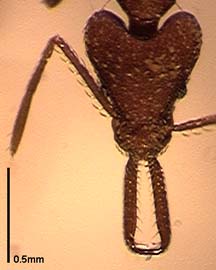Strumigenys ludia Mann 1922
Dacetini, Myrmicinae, Formicidae, Hymenoptera, Insecta, Arthropoda, Animalia
John T. Longino, The Evergreen State College, Olympia WA 98505
USA.
longinoj@evergreen.edu
22 April 1997

Specimen: Costa Rica, Prov. Heredia: La Selva (J. Longino 3222). INBIOCRI001237630. Image by J. Longino. line drawing of lateral view (from Brown 1962)
Identification
Apical fork of mandible with one intercalary tooth; mandible with no preapical teeth; petiole with node only feebly differentiated from its anterior peduncle; gastral hairs mostly stiff, spatulate.
Head length 0.67-0.74mm, mandible length 0.49-0.56, CI 81-84, MI 73-76 (n=9 workers from 6 localities; Brown 1962).
Similar species: elongata, precava, consanii.
|

Specimen: Costa Rica, Prov. Heredia: La Selva (J. Longino 3222). INBIOCRI001237630. Image by J. Longino. line drawing of worker face (from Brown 1962) |
Range
Southern Mexico to Costa Rica. Costa Rica: Atlantic lowlands.
Natural History
Brown and Wilson (1959) summarize the genus as follows:
"Widespread in tropics and warm temperate areas. Primarily forest-dwelling; some species occur in grassland and arid scrub. ... Nests mostly in soil and rotting wood; a few species live in arboreal plant cavities in tropical rain forest. Foraging hypogaeic to epigaeic-arboreal. Food: most species are collembolan feeders; a few are polyphagous predators or occasionally feed on sugary substances..."
Brown (1962) reports that ludia is a forest species and usually nests in rotten branches or twigs lying on the forest floor. He also reports that the food is chiefly entomobryoid Collembola. In Costa Rica, I have observed ludia in young second growth habitats, and not in Winkler or other samples from mature forest. Thus, this species may be associated with synanthropic habitats.
Selected Records
Abaca plantation, Batan (near Limon): collection reported in Brown (1962).
La Selva: three records of foragers and one ALAS Berlese sample, all from second growth habitat.
Literature Cited
Brown, W. L., Jr. 1954(1953). The neotropical species of the ant genus Strumigenys Fr. Smith: Group of elongata Roger. Journal of the New York Entomological Society 61:189-200.
Brown, W. L., Jr. 1962. The neotropical species of the ant genus Strumigenys Fr. Smith: Synopsis and keys to the species. Psyche 69:238-267.
Brown, W. L., Jr., Wilson, E. O. 1959. The evolution of the dacetine ants. Quart. Rev. Biol. 34:278-294.
 Go back to top
Go back to top

